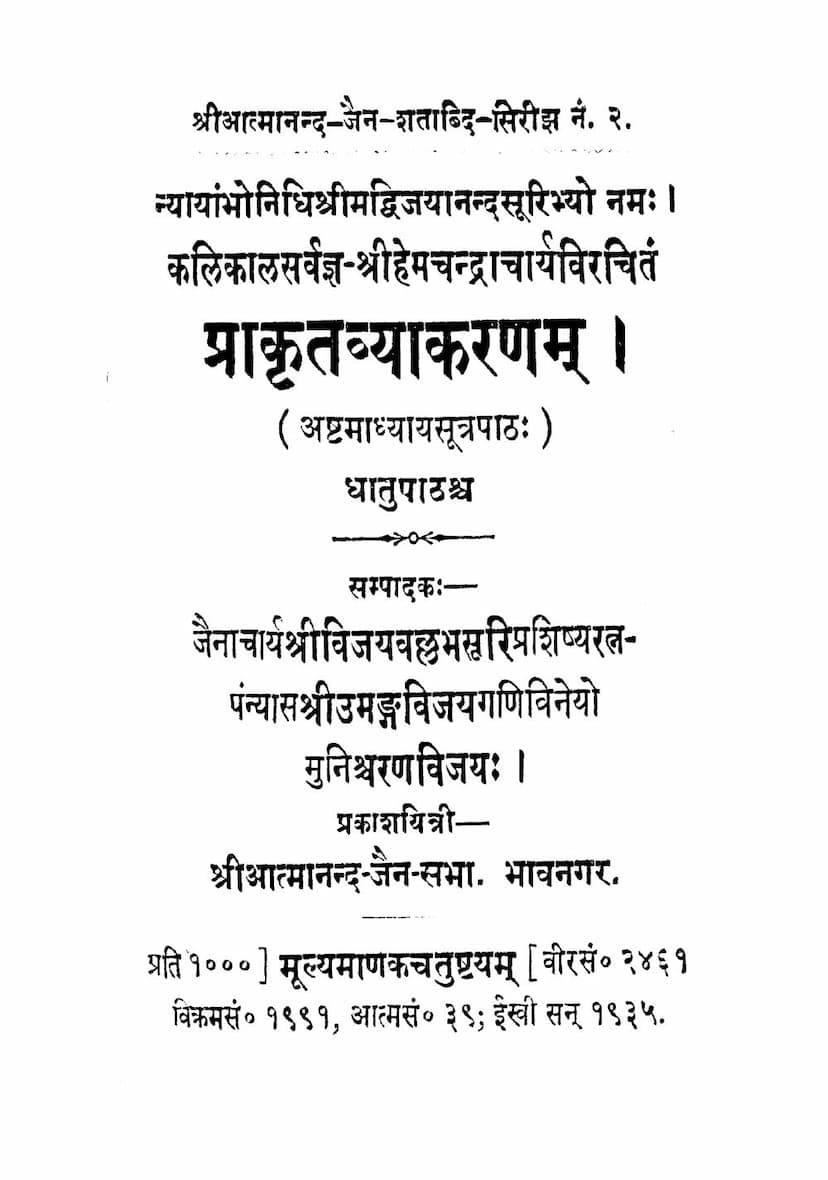Prakrit Vyakaranam
Added to library: September 2, 2025

Summary
This document is a published edition of the Prakrit Vyakaranam (Grammar of Prakrit) by the renowned Jain Acharya Hemachandrasuri. The specific text presented is the Eighth Chapter of his larger work, the Siddha-Hema-Shabdānushasana.
Here's a breakdown of the content and its significance based on the provided pages:
1. Title and Author:
- Title: Prakrit Vyakaranam (प्राकृतव्याकरणम्)
- Author: Kalikal-sarvajna Shri Hemachandracharya (कलिकालसर्वज्ञ-श्रीहेमचन्द्राचार्य)
- Publisher: Shri Atmanand Jain Sabha, Bhavnagar (श्रीआत्मानन्द-जैन-सभा. भावनगर.)
- Editors/Compilers: Munishri Charanvijay (मुनिश्वरणविजयः), disciple of Acharya Shri Vijayavallabh Surishwarji Maharaj.
2. Publication Details:
- Series: Shri Atmanand Jain Shatabdhi Series No. 2 (श्रीआत्मानन्द-जैन-शताब्दि-सिरीझ नं. २.)
- Year of Publication: Veer Samvat 2461 / Vikram Samvat 1991 / Adam Samvat 39 / AD 1935.
- Printed at: Nirnaya Sagar Press, Bombay.
- Value: Four Rupees (मूल्यमाणकचतुष्टयम्).
3. Dedication (Samarpan - Page 3): The book is humbly dedicated to Munishri Punyavijayji Maharaj. The author, Muni Charanvijay, expresses his deep gratitude for the spiritual guidance and the time Punyavijayji Maharaj dedicated to teaching him the Prakrit grammar during his chaturmas (a four-month rainy season retreat) in Patan. This teaching, under the blessings of Acharya Shri Vijayavallabh Surishwarji Maharaj, enabled Charanvijay to gain some understanding of Prakrit and related languages.
4. Publisher's Introduction (Nivedan - Pages 7-11):
- The Shri Atmanand Jain Sabha expresses immense pleasure in presenting this foundational text of Prakrit Grammar.
- Hemachandracharya: He is described as a great philosopher and kalikal-sarvajna (omniscient of the present age), and the one who enlightened King Kumarpal. He created a comprehensive Sanskrit and Prakrit grammar, the Siddha-Hema-Shabdānushasana, comprising 125,000 Sanskrit verses (slokas).
- Comparison with Panini: The introduction draws a parallel with Maharshi Panini, who included Vedic usages in his grammar. Hemachandracharya, similarly, dedicated a separate Eighth Chapter to Prakrit and related languages within his Siddha-Hema-Shabdānushasana to explain the usages found in Jain Agama texts. Panini's Ashtadhyayi has seven chapters for Sanskrit, while Hemachandracharya's work, after completing seven chapters on Sanskrit grammar, dedicates the eighth chapter specifically to the rules of six languages.
- Structure of the Eighth Chapter: The Eighth Chapter is meticulously structured with four padas (sections).
- Padas 1-3 (and part of 4): Contain rules for Prakrit usages.
- Part of Pada 4: Begins with Shauraseni, followed by Magadhi, Paishachi, Chullika-Paishachi, and finally Apabhramsha, with rules for each.
- Comprehensiveness: Hemachandracharya's Prakrit grammar is considered unparalleled in its detail. While other Prakrit grammars exist (like Shatbhasha Chandrika, Prakrit Prakash, Prakrit Lakshana), they are generally concise. The extensive coverage of six languages in Hemachandracharya's work is unmatched.
- Purpose of this Edition: The edition focuses on the Moola Sutras (original aphorisms) of Hemachandracharya's Prakrit grammar. The publisher believes that mastering these concise aphorisms, with attention to continuity and context, can provide significant knowledge of Prakrit and Magadhi with minimal effort. Many sutras are self-explanatory and do not require a commentary (vritti).
- Pocket Size: The edition is intentionally produced in a small, pocket-sized format for easy carrying and memorization by students, monks, and nuns. This contrasts with larger, commentary-filled editions.
- Dhatupatha (List of Roots): At the end of the Prakrit grammar section, a detailed Dhatupatha (list of verb roots) is provided, arranged alphabetically. It includes Prakrit roots, their Sanskrit equivalents, and corresponding Prakrit sutra numbers, presented in three sections per page for ease of use. This acts as a dictionary for identifying Sanskrit roots based on their Prakrit forms.
- Acknowledgments: Special thanks are given to Shah Dahyabhai Popatlal of Ahmedabad for his significant financial assistance. Gratitude is also extended to Munishri Punyavijayji Maharaj for meticulously reviewing and finalizing the proofs.
5. The Prakrit Grammar Text (Pages 13-97): The bulk of the document consists of the actual sutras of the Eighth Chapter of Hemachandracharya's grammar. This chapter systematically outlines the grammatical rules, phonetic changes, and word formations for various Prakrit dialects, including:
- Pada 1 (Pages 13-32): Covers general Prakrit rules.
- Pada 2 (Pages 33-48): Continues with various phonetic and grammatical transformations.
- Pada 3 (Pages 49-58): Deals with pronouns and their inflections.
- Pada 4 (Pages 59-93): Focuses on verb roots and their transformations in different Prakrit dialects, including specific rules for Shauraseni, Magadhi, Paishachi, Chullika-Paishachi, and Apabhramsha.
6. Dhatupatha (Pages 98-134): This section is an index or dictionary of Prakrit roots, mapping them to their Sanskrit equivalents and the specific sutra number in the Eighth Chapter where their usage or transformation is explained. This is a valuable tool for scholars and students to understand the etymology and grammatical treatment of Prakrit words.
7. Concluding Remarks and Colophon (Pages 32, 48, 58, 62, 86, 92, 93, 95, 96): The end of each pada (section) is marked with a colophon. The end of the Eighth Chapter and the entire Prakrit Vyakaranam section is also noted, including verses glorifying the lineage of rulers and the author.
In essence, this document is a critical edition of the Prakrit grammar section of Hemachandracharya's seminal work, presented by the Shri Atmanand Jain Sabha, with the aim of making these foundational texts accessible for study and memorization, particularly for the Jain community. It highlights Hemachandracharya's scholarly contribution to the understanding of Prakrit languages and their importance in Jain religious literature.